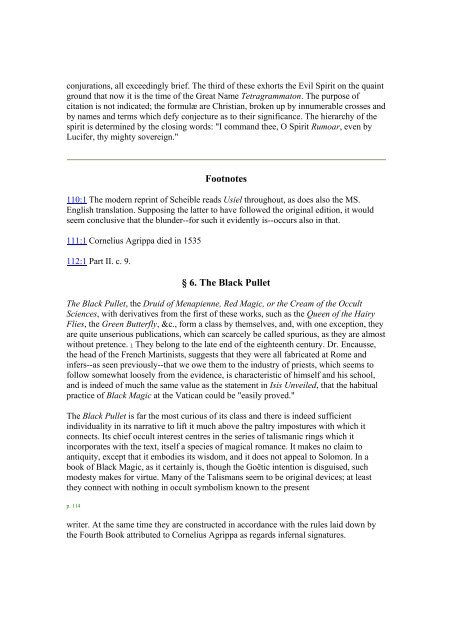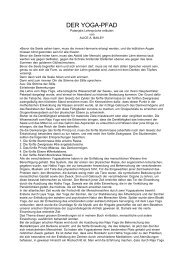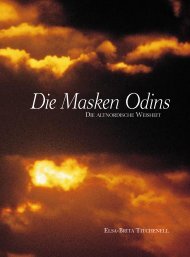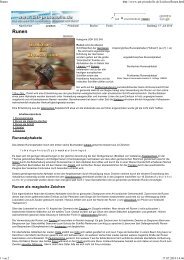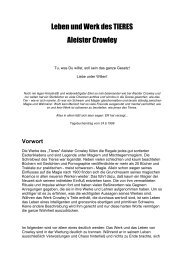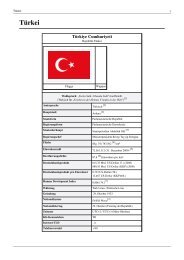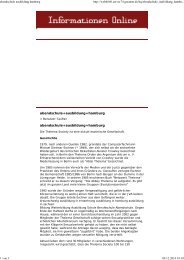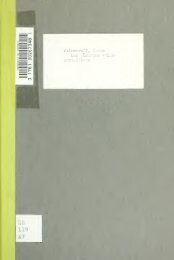The Book of ceremonial Magic
The Book of ceremonial Magic
The Book of ceremonial Magic
Create successful ePaper yourself
Turn your PDF publications into a flip-book with our unique Google optimized e-Paper software.
conjurations, all exceedingly brief. <strong>The</strong> third <strong>of</strong> these exhorts the Evil Spirit on the quaint<br />
ground that now it is the time <strong>of</strong> the Great Name Tetragrammaton. <strong>The</strong> purpose <strong>of</strong><br />
citation is not indicated; the formulæ are Christian, broken up by innumerable crosses and<br />
by names and terms which defy conjecture as to their significance. <strong>The</strong> hierarchy <strong>of</strong> the<br />
spirit is determined by the closing words: "I command thee, O Spirit Rumoar, even by<br />
Lucifer, thy mighty sovereign."<br />
Footnotes<br />
110:1 <strong>The</strong> modern reprint <strong>of</strong> Scheible reads Usiel throughout, as does also the MS.<br />
English translation. Supposing the latter to have followed the original edition, it would<br />
seem conclusive that the blunder--for such it evidently is--occurs also in that.<br />
111:1 Cornelius Agrippa died in 1535<br />
112:1 Part II. c. 9.<br />
§ 6. <strong>The</strong> Black Pullet<br />
<strong>The</strong> Black Pullet, the Druid <strong>of</strong> Menapienne, Red <strong>Magic</strong>, or the Cream <strong>of</strong> the Occult<br />
Sciences, with derivatives from the first <strong>of</strong> these works, such as the Queen <strong>of</strong> the Hairy<br />
Flies, the Green Butterfly, &c., form a class by themselves, and, with one exception, they<br />
are quite unserious publications, which can scarcely be called spurious, as they are almost<br />
without pretence. 1 <strong>The</strong>y belong to the late end <strong>of</strong> the eighteenth century. Dr. Encausse,<br />
the head <strong>of</strong> the French Martinists, suggests that they were all fabricated at Rome and<br />
infers--as seen previously--that we owe them to the industry <strong>of</strong> priests, which seems to<br />
follow somewhat loosely from the evidence, is characteristic <strong>of</strong> himself and his school,<br />
and is indeed <strong>of</strong> much the same value as the statement in Isis Unveiled, that the habitual<br />
practice <strong>of</strong> Black <strong>Magic</strong> at the Vatican could be "easily proved."<br />
<strong>The</strong> Black Pullet is far the most curious <strong>of</strong> its class and there is indeed sufficient<br />
individuality in its narrative to lift it much above the paltry impostures with which it<br />
connects. Its chief occult interest centres in the series <strong>of</strong> talismanic rings which it<br />
incorporates with the text, itself a species <strong>of</strong> magical romance. It makes no claim to<br />
antiquity, except that it embodies its wisdom, and it does not appeal to Solomon. In a<br />
book <strong>of</strong> Black <strong>Magic</strong>, as it certainly is, though the Goëtic intention is disguised, such<br />
modesty makes for virtue. Many <strong>of</strong> the Talismans seem to be original devices; at least<br />
they connect with nothing in occult symbolism known to the present<br />
p. 114<br />
writer. At the same time they are constructed in accordance with the rules laid down by<br />
the Fourth <strong>Book</strong> attributed to Cornelius Agrippa as regards infernal signatures.


